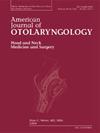青少年血管纤维瘤血管化模式的研究及术前栓塞对手术切除的影响
IF 1.7
4区 医学
Q2 OTORHINOLARYNGOLOGY
引用次数: 0
摘要
青少年鼻咽血管纤维瘤(JNA)是一种罕见的高血管性肿瘤,由于术中大量出血,对内镜切除构成重大挑战。探查供血血管及术前栓塞可减少术中出血量,改善JNA手术效果。本研究探讨JNA的血管形成模式以及术前栓塞对手术切除的影响。方法对30例组织病理学证实的JNA患者进行描述性横断面研究,这些患者于2019年1月至2023年5月在胡志明市耳鼻喉医院接受术前栓塞和内镜手术切除。分析肿瘤血管分布及术前栓塞的作用。结果绝大多数肿瘤均由上颌内动脉供血,占50%,其中20%由双侧上颌内动脉供血。累及IMA和其他颈外动脉分支的联合供血模式占26.6%。3例复杂病例(10%)接受颈内动脉(ICA)供血。为了避免并发症,我们对颈外动脉(ECA)分支进行了栓塞,而不是颈外动脉分支。所有患者均完成了内镜下JNA的完全切除。平均术中出血量608 mL(范围:100 mL ~ 3000 mL),平均Boezaart评分2.63。围手术期无重大手术并发症发生。不同UPMC肿瘤分期患者的出血量差异有统计学意义(p <;0.001)和肿瘤大小(p = 0.008)。晚期肿瘤更可能有ICA血供(p = 0.038)。结论了解青少年血管纤维瘤的血管形成模式及术前栓塞的作用,有助于内镜下肿瘤的切除。本文章由计算机程序翻译,如有差异,请以英文原文为准。
Investigation of vascularization patterns in juvenile Angiofibroma and the impact of preoperative embolization on surgical excision
Background
Juvenile nasopharyngeal angiofibroma (JNA) is a rare, highly vascular tumor posing a significant challenge for endoscopic excision due to excessive intraoperative bleeding. Exploring feeding vessels and preoperative embolization could reduce intraoperative blood loss and improve surgical outcomes for JNA. This study investigates the vascularization patterns of JNA and the impact of preoperative embolization on surgical excision.
Methods
This was a descriptive cross-sectional study of 30 histopathologically confirmed JNA patients who underwent preoperative embolization followed by endoscopic surgical excision from January 2019 to May 2023 at Ear Nose Throat Hospital of Ho Chi Minh City. The distribution of vascular supply of tumors, as well as the role of preoperative embolization, were analyzed.
Results
Most tumors received exclusive blood supply from the internal maxillary artery (IMA) accounting for 50%, with 20% of cases being supplied by bilateral IMAs. A combined supply pattern involving the IMA and other external carotid artery branches was observed in 26.6%. Three complex cases (10%) received blood from the internal carotid artery (ICA). Embolization was performed at branches originating from the external carotid artery (ECA) but not from the ICA to avoid complications. All patients achieved complete endoscopic JNA excision. The average intraoperative blood loss was 608 mL (range: 100 mL - 3000 mL), and the average Boezaart score was 2.63. No major surgical complications occurred in the perioperative period. Significant differences in blood loss were observed among different UPMC tumor stages (p < 0.001) and tumor sizes (p = 0.008). Advanced-stage tumors were more likely to have an ICA blood supply (p = 0.038).
Conclusion
Understanding the vascularization patterns of juvenile angiofibroma and the role of preoperative embolization can facilitate endoscopic excision of these tumors.
求助全文
通过发布文献求助,成功后即可免费获取论文全文。
去求助
来源期刊

American Journal of Otolaryngology
医学-耳鼻喉科学
CiteScore
4.40
自引率
4.00%
发文量
378
审稿时长
41 days
期刊介绍:
Be fully informed about developments in otology, neurotology, audiology, rhinology, allergy, laryngology, speech science, bronchoesophagology, facial plastic surgery, and head and neck surgery. Featured sections include original contributions, grand rounds, current reviews, case reports and socioeconomics.
 求助内容:
求助内容: 应助结果提醒方式:
应助结果提醒方式:


